2007 CHEVROLET EXPRESS CARGO VAN air condition
[x] Cancel search: air conditionPage 86 of 458
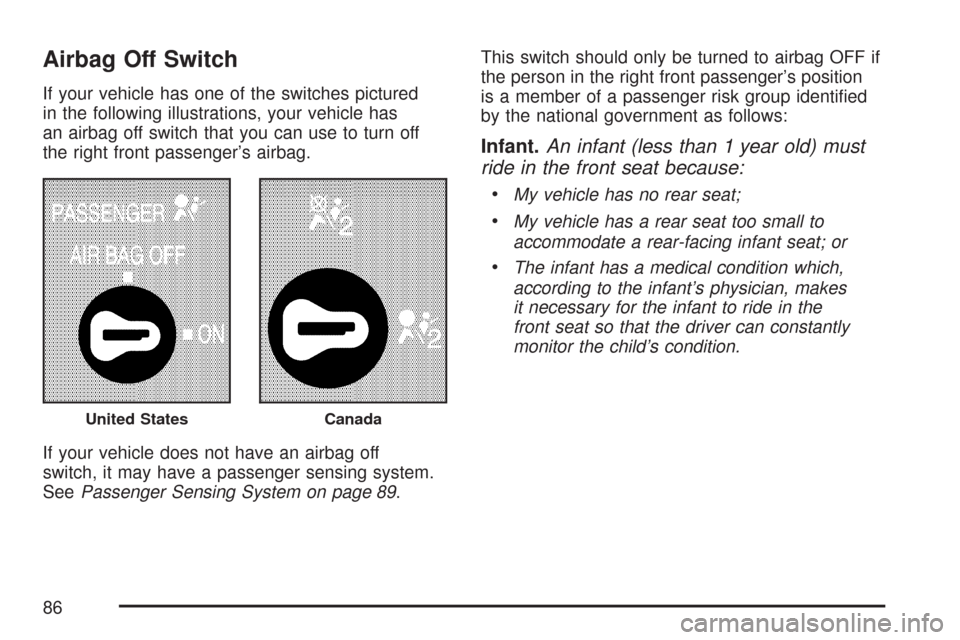
Airbag Off Switch
If your vehicle has one of the switches pictured
in the following illustrations, your vehicle has
an airbag off switch that you can use to turn off
the right front passenger’s airbag.
If your vehicle does not have an airbag off
switch, it may have a passenger sensing system.
SeePassenger Sensing System on page 89.This switch should only be turned to airbag OFF if
the person in the right front passenger’s position
is a member of a passenger risk group identified
by the national government as follows:
Infant.An infant (less than 1 year old) must
ride in the front seat because:
•
My vehicle has no rear seat;
•My vehicle has a rear seat too small to
accommodate a rear-facing infant seat; or
•The infant has a medical condition which,
according to the infant’s physician, makes
it necessary for the infant to ride in the
front seat so that the driver can constantly
monitor the child’s condition.
United StatesCanada
86
Page 87 of 458
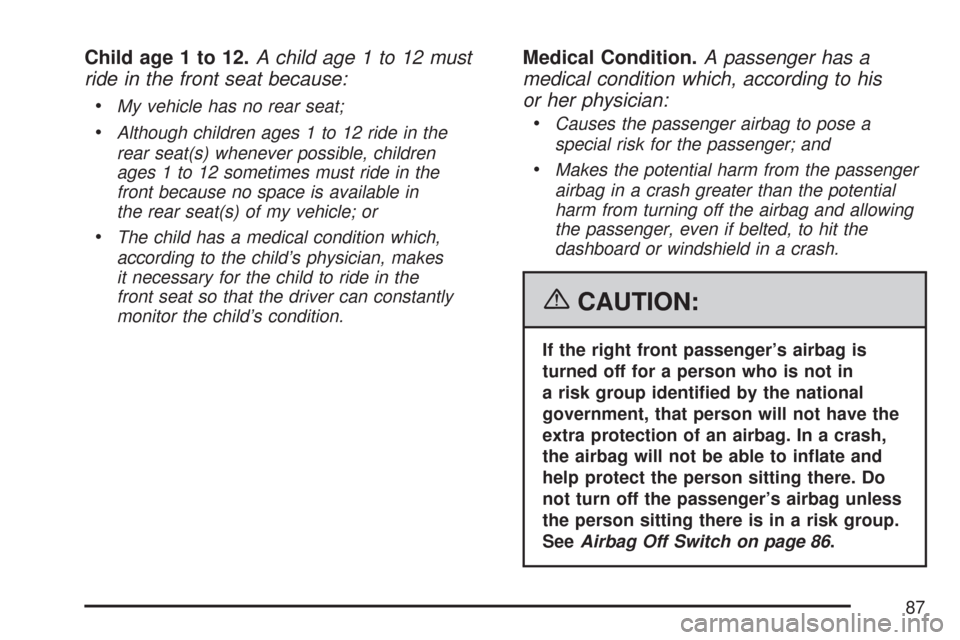
Child age 1 to 12.A child age 1 to 12 must
ride in the front seat because:
•
My vehicle has no rear seat;
•Although children ages 1 to 12 ride in the
rear seat(s) whenever possible, children
ages 1 to 12 sometimes must ride in the
front because no space is available in
the rear seat(s) of my vehicle; or
•The child has a medical condition which,
according to the child’s physician, makes
it necessary for the child to ride in the
front seat so that the driver can constantly
monitor the child’s condition.
Medical Condition.A passenger has a
medical condition which, according to his
or her physician:
•
Causes the passenger airbag to pose a
special risk for the passenger; and
•Makes the potential harm from the passenger
airbag in a crash greater than the potential
harm from turning off the airbag and allowing
the passenger, even if belted, to hit the
dashboard or windshield in a crash.
{CAUTION:
If the right front passenger’s airbag is
turned off for a person who is not in
a risk group identi�ed by the national
government, that person will not have the
extra protection of an airbag. In a crash,
the airbag will not be able to in�ate and
help protect the person sitting there. Do
not turn off the passenger’s airbag unless
the person sitting there is in a risk group.
SeeAirbag Off Switch on page 86.
87
Page 90 of 458
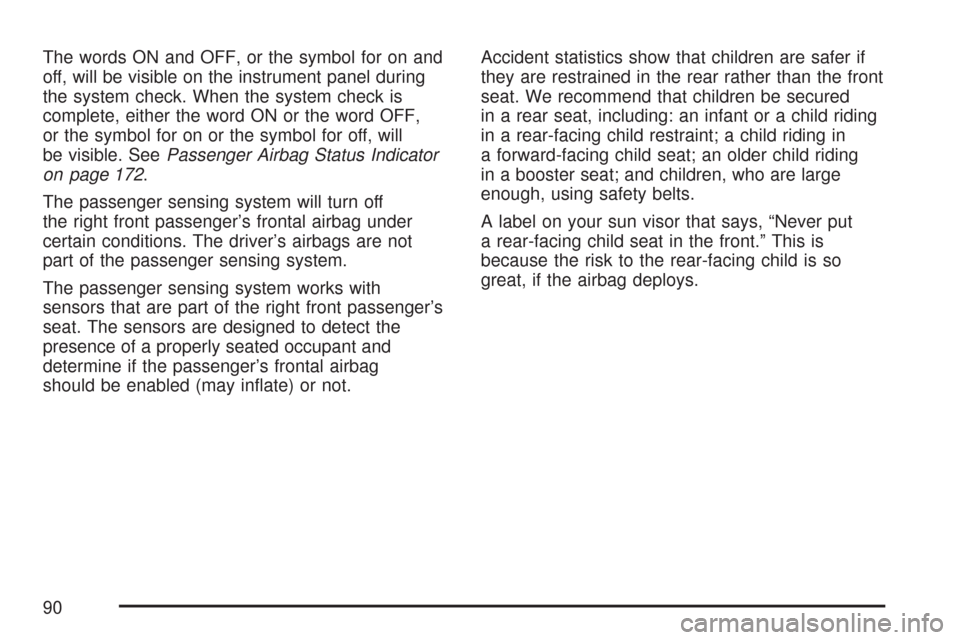
The words ON and OFF, or the symbol for on and
off, will be visible on the instrument panel during
the system check. When the system check is
complete, either the word ON or the word OFF,
or the symbol for on or the symbol for off, will
be visible. SeePassenger Airbag Status Indicator
on page 172.
The passenger sensing system will turn off
the right front passenger’s frontal airbag under
certain conditions. The driver’s airbags are not
part of the passenger sensing system.
The passenger sensing system works with
sensors that are part of the right front passenger’s
seat. The sensors are designed to detect the
presence of a properly seated occupant and
determine if the passenger’s frontal airbag
should be enabled (may inflate) or not.Accident statistics show that children are safer if
they are restrained in the rear rather than the front
seat. We recommend that children be secured
in a rear seat, including: an infant or a child riding
in a rear-facing child restraint; a child riding in
a forward-facing child seat; an older child riding
in a booster seat; and children, who are large
enough, using safety belts.
A label on your sun visor that says, “Never put
a rear-facing child seat in the front.” This is
because the risk to the rear-facing child is so
great, if the airbag deploys.
90
Page 127 of 458
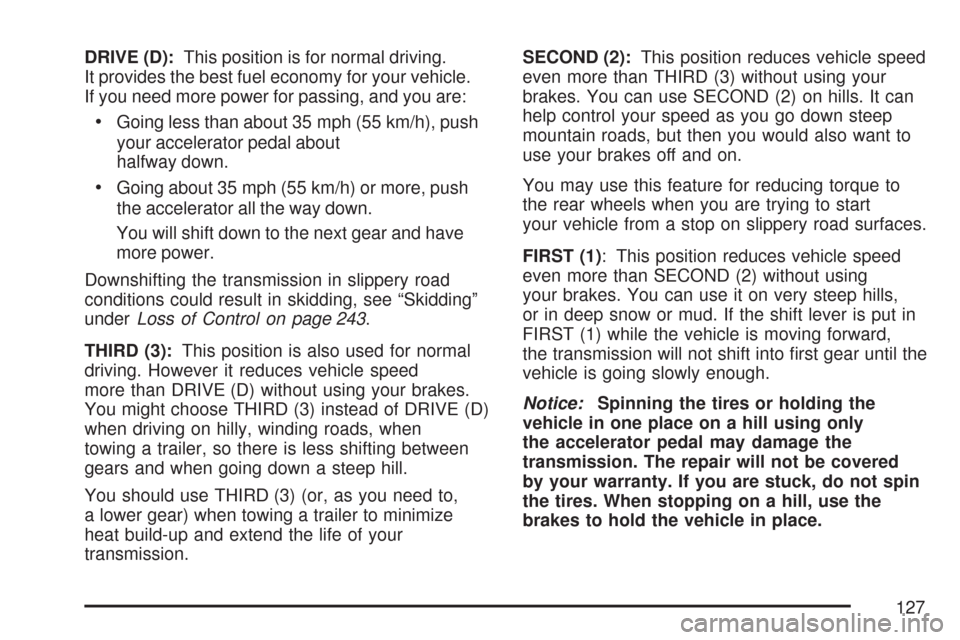
DRIVE (D):This position is for normal driving.
It provides the best fuel economy for your vehicle.
If you need more power for passing, and you are:
•Going less than about 35 mph (55 km/h), push
your accelerator pedal about
halfway down.
•Going about 35 mph (55 km/h) or more, push
the accelerator all the way down.
You will shift down to the next gear and have
more power.
Downshifting the transmission in slippery road
conditions could result in skidding, see “Skidding”
underLoss of Control on page 243.
THIRD (3):This position is also used for normal
driving. However it reduces vehicle speed
more than DRIVE (D) without using your brakes.
You might choose THIRD (3) instead of DRIVE (D)
when driving on hilly, winding roads, when
towing a trailer, so there is less shifting between
gears and when going down a steep hill.
You should use THIRD (3) (or, as you need to,
a lower gear) when towing a trailer to minimize
heat build-up and extend the life of your
transmission.SECOND (2):This position reduces vehicle speed
even more than THIRD (3) without using your
brakes. You can use SECOND (2) on hills. It can
help control your speed as you go down steep
mountain roads, but then you would also want to
use your brakes off and on.
You may use this feature for reducing torque to
the rear wheels when you are trying to start
your vehicle from a stop on slippery road surfaces.
FIRST (1): This position reduces vehicle speed
even more than SECOND (2) without using
your brakes. You can use it on very steep hills,
or in deep snow or mud. If the shift lever is put in
FIRST (1) while the vehicle is moving forward,
the transmission will not shift into first gear until the
vehicle is going slowly enough.
Notice:Spinning the tires or holding the
vehicle in one place on a hill using only
the accelerator pedal may damage the
transmission. The repair will not be covered
by your warranty. If you are stuck, do not spin
the tires. When stopping on a hill, use the
brakes to hold the vehicle in place.
127
Page 141 of 458
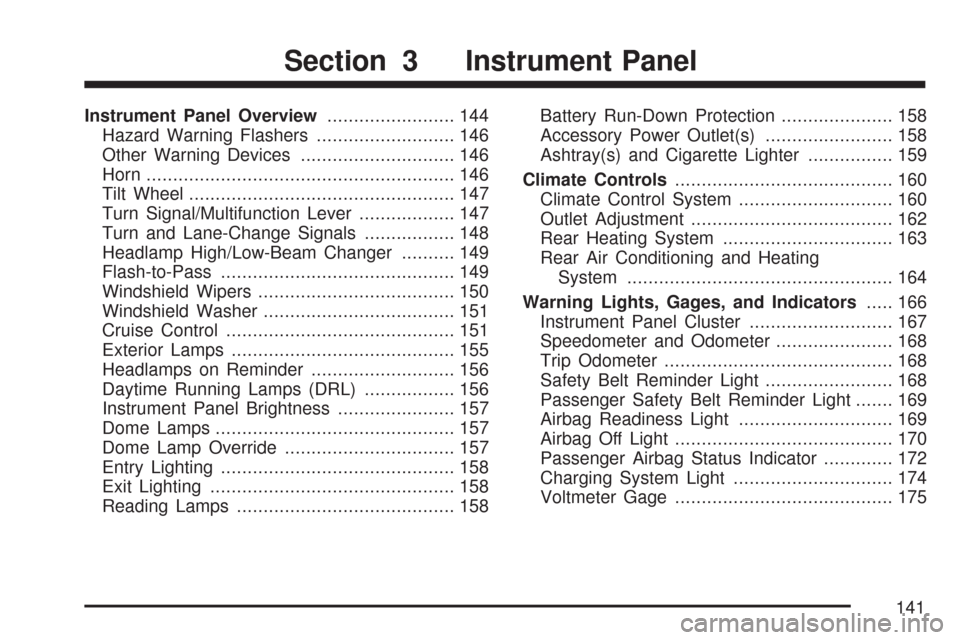
Instrument Panel Overview........................ 144
Hazard Warning Flashers.......................... 146
Other Warning Devices............................. 146
Horn.......................................................... 146
Tilt Wheel.................................................. 147
Turn Signal/Multifunction Lever.................. 147
Turn and Lane-Change Signals................. 148
Headlamp High/Low-Beam Changer.......... 149
Flash-to-Pass............................................ 149
Windshield Wipers..................................... 150
Windshield Washer.................................... 151
Cruise Control........................................... 151
Exterior Lamps.......................................... 155
Headlamps on Reminder........................... 156
Daytime Running Lamps (DRL)................. 156
Instrument Panel Brightness...................... 157
Dome Lamps............................................. 157
Dome Lamp Override................................ 157
Entry Lighting............................................ 158
Exit Lighting.............................................. 158
Reading Lamps......................................... 158Battery Run-Down Protection..................... 158
Accessory Power Outlet(s)........................ 158
Ashtray(s) and Cigarette Lighter................ 159
Climate Controls......................................... 160
Climate Control System............................. 160
Outlet Adjustment...................................... 162
Rear Heating System................................ 163
Rear Air Conditioning and Heating
System.................................................. 164
Warning Lights, Gages, and Indicators..... 166
Instrument Panel Cluster........................... 167
Speedometer and Odometer...................... 168
Trip Odometer........................................... 168
Safety Belt Reminder Light........................ 168
Passenger Safety Belt Reminder Light....... 169
Airbag Readiness Light............................. 169
Airbag Off Light......................................... 170
Passenger Airbag Status Indicator............. 172
Charging System Light.............................. 174
Voltmeter Gage......................................... 175
Section 3 Instrument Panel
141
Page 161 of 458
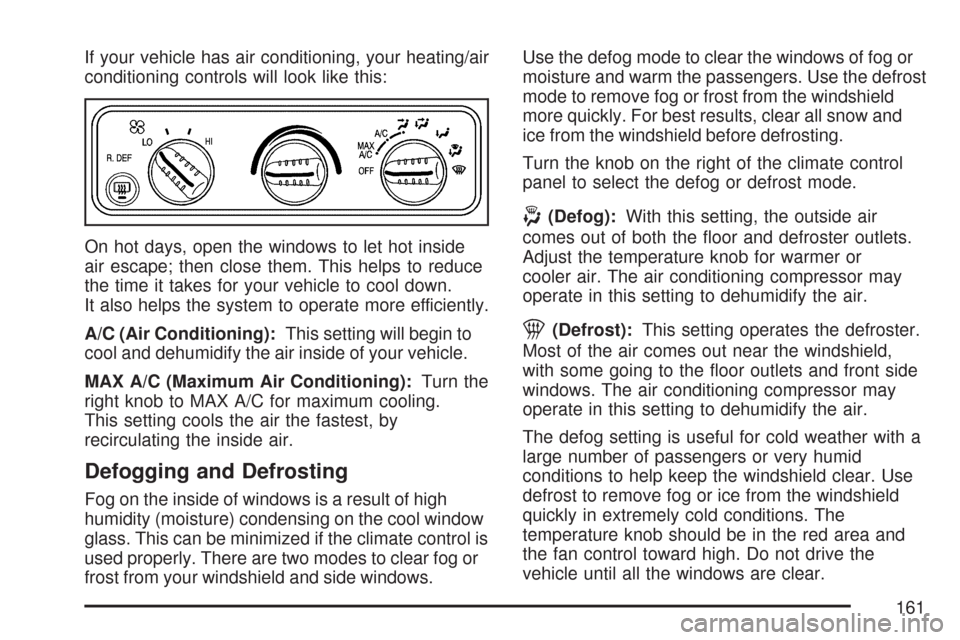
If your vehicle has air conditioning, your heating/air
conditioning controls will look like this:
On hot days, open the windows to let hot inside
air escape; then close them. This helps to reduce
the time it takes for your vehicle to cool down.
It also helps the system to operate more efficiently.
A/C (Air Conditioning):This setting will begin to
cool and dehumidify the air inside of your vehicle.
MAX A/C (Maximum Air Conditioning):Turn the
right knob to MAX A/C for maximum cooling.
This setting cools the air the fastest, by
recirculating the inside air.
Defogging and Defrosting
Fog on the inside of windows is a result of high
humidity (moisture) condensing on the cool window
glass. This can be minimized if the climate control is
used properly. There are two modes to clear fog or
frost from your windshield and side windows.Use the defog mode to clear the windows of fog or
moisture and warm the passengers. Use the defrost
mode to remove fog or frost from the windshield
more quickly. For best results, clear all snow and
ice from the windshield before defrosting.
Turn the knob on the right of the climate control
panel to select the defog or defrost mode.
-(Defog):With this setting, the outside air
comes out of both the floor and defroster outlets.
Adjust the temperature knob for warmer or
cooler air. The air conditioning compressor may
operate in this setting to dehumidify the air.
1(Defrost):This setting operates the defroster.
Most of the air comes out near the windshield,
with some going to the floor outlets and front side
windows. The air conditioning compressor may
operate in this setting to dehumidify the air.
The defog setting is useful for cold weather with a
large number of passengers or very humid
conditions to help keep the windshield clear. Use
defrost to remove fog or ice from the windshield
quickly in extremely cold conditions. The
temperature knob should be in the red area and
the fan control toward high. Do not drive the
vehicle until all the windows are clear.
161
Page 164 of 458
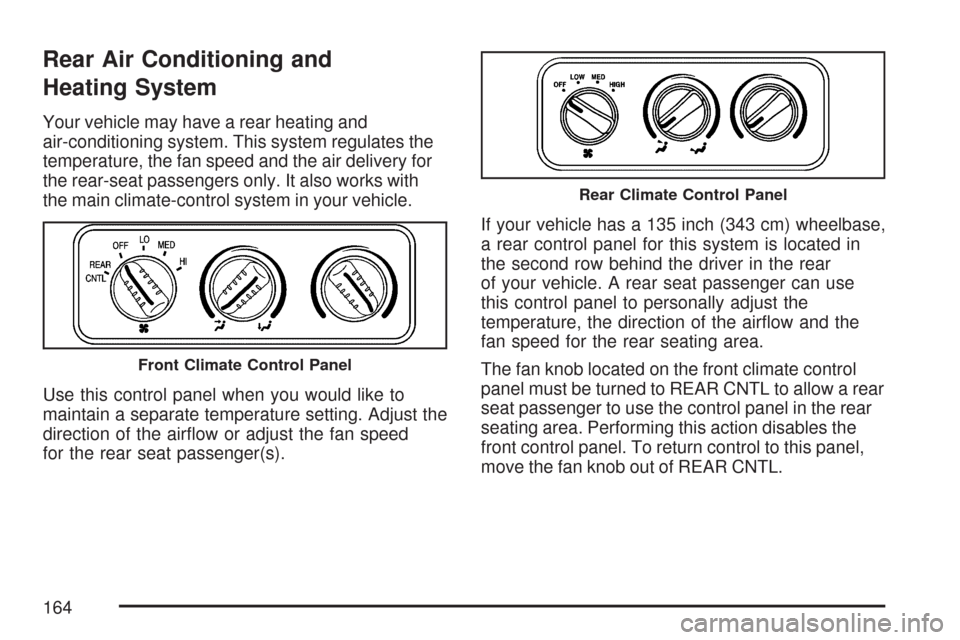
Rear Air Conditioning and
Heating System
Your vehicle may have a rear heating and
air-conditioning system. This system regulates the
temperature, the fan speed and the air delivery for
the rear-seat passengers only. It also works with
the main climate-control system in your vehicle.
Use this control panel when you would like to
maintain a separate temperature setting. Adjust the
direction of the airflow or adjust the fan speed
for the rear seat passenger(s).If your vehicle has a 135 inch (343 cm) wheelbase,
a rear control panel for this system is located in
the second row behind the driver in the rear
of your vehicle. A rear seat passenger can use
this control panel to personally adjust the
temperature, the direction of the airflow and the
fan speed for the rear seating area.
The fan knob located on the front climate control
panel must be turned to REAR CNTL to allow a rear
seat passenger to use the control panel in the rear
seating area. Performing this action disables the
front control panel. To return control to this panel,
move the fan knob out of REAR CNTL.
Front Climate Control Panel
Rear Climate Control Panel
164
Page 165 of 458
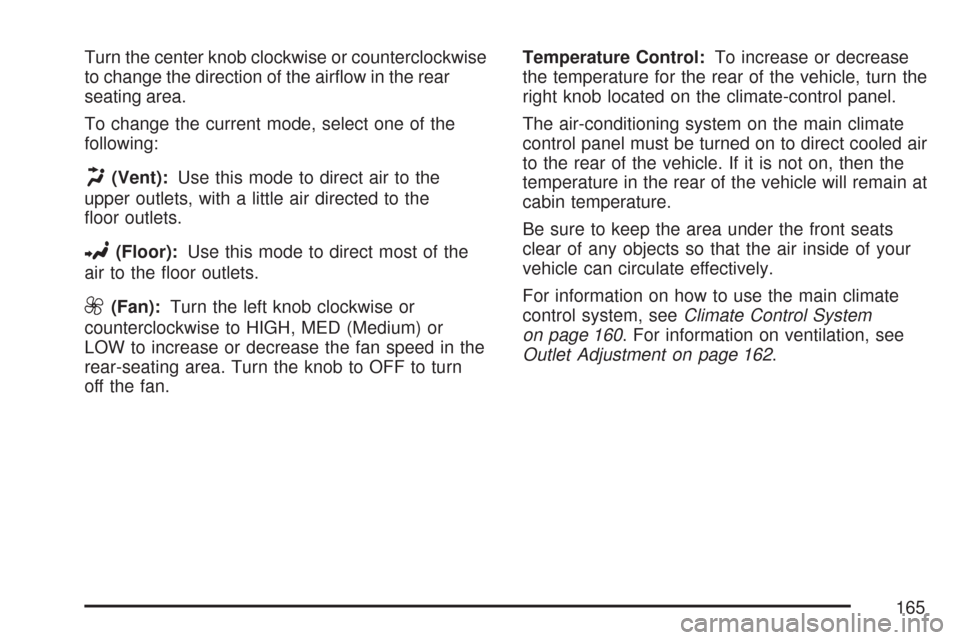
Turn the center knob clockwise or counterclockwise
to change the direction of the airflow in the rear
seating area.
To change the current mode, select one of the
following:
H(Vent):Use this mode to direct air to the
upper outlets, with a little air directed to the
floor outlets.
2(Floor):Use this mode to direct most of the
air to the floor outlets.
9(Fan):Turn the left knob clockwise or
counterclockwise to HIGH, MED (Medium) or
LOW to increase or decrease the fan speed in the
rear-seating area. Turn the knob to OFF to turn
off the fan.Temperature Control:To increase or decrease
the temperature for the rear of the vehicle, turn the
right knob located on the climate-control panel.
The air-conditioning system on the main climate
control panel must be turned on to direct cooled air
to the rear of the vehicle. If it is not on, then the
temperature in the rear of the vehicle will remain at
cabin temperature.
Be sure to keep the area under the front seats
clear of any objects so that the air inside of your
vehicle can circulate effectively.
For information on how to use the main climate
control system, seeClimate Control System
on page 160. For information on ventilation, see
Outlet Adjustment on page 162.
165